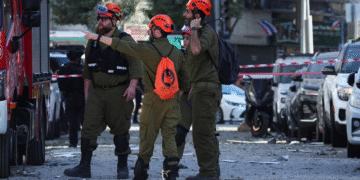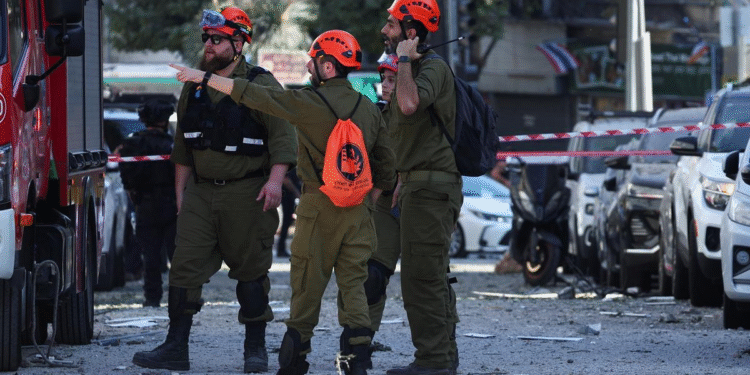U.S. strikes three nuclear facilities in Iran; Trump warns Iran of more attacks if they “don’t make peace now”; Iran’s Foreign Minister says U.S. attacks will have “everlasting consequences”; Iran responds by calling for a emergency UNSC meeting and also with a barrage of missiles on Israel
First responders gather at an impact site following Iran’s strike on Israel, amid the Iran-Israel conflict, in Haifa, on June 22, 2025. | Photo Credit: Reuters
U.S. President Donald Trump on Sunday (June 22, 2025) said the country has carried out a “very successful attack” on three Iranian nuclear sites — Fordo, Natanz and Esfahan — including the crucial underground uranium enrichment facility at Fordo. He made the surprise announcement just two days after saying he had opened a two-week window for diplomacy.
In his address after the strikes, Mr. Trump said that Iran’s nuclear enrichment facilities have been “completely and totally obliterated” and warned Iran of “far greater” attacks if they “dont make peace now”
Iran’s Foreign Minister Abbas Araghchi condemned the attacks. “The United States, a permanent member of the United Nations Security Council, has committed a grave violation of the UN Charter, international law and the NPT by attacking Iran’s peaceful nuclear installations. The events this morning are outrageous and will have everlasting consequences. Each and every member of the UN must be alarmed over this extremely dangerous, lawless and criminal behavior. In accordance with the UN Charter and its provisions allowing a legitimate response in self-defense, Iran reserves all options to defend its sovereignty, interest, and people,” he said in a post on X.

After the U.S. strikes, Iran launched a barrage of missiles on Israel, as confirmed by both sides.
Israeli media reported several explosions over various parts of the country, including Tel Aviv. The Israeli military too said it launched fresh strikes on military targets, including missile launchers, in western Iran.
Israel and Iran traded strikes a week into their war on Friday (June 20, 2025) as key European ministers met with Iran’s top diplomat in Geneva in a scramble to de-escalate the conflict. But the first face-to-face meeting between Western and Iranian officials in the weeklong war concluded after four hours with no sign of an immediate breakthrough.
The already fragile Middle East erupted into chaos today as the United States launched targeted strikes against key Iranian nuclear facilities. The military offensive—confirmed by Pentagon sources early Sunday—follows weeks of growing tension between Iran and Israel. Iranian officials responded immediately with direct missile attacks on Israeli targets, sparking a new phase in what analysts now call the most dangerous regional escalation in over a decade.
As of this writing, at least 16 people have been injured in missile strikes on central and southern Israel, with both Tel Aviv and Beersheba reporting direct hits. Air raid sirens and Iron Dome interceptions filled the early morning air, while Israeli fighter jets retaliated with bombing runs over suspected IRGC (Islamic Revolutionary Guard Corps) positions in western Iran and Syria.

According to senior U.S. defense officials, the airstrikes were launched after “irrefutable intelligence” showed Iran was resuming uranium enrichment at Fordow and Natanz, two of the most heavily fortified nuclear installations in the country. Satellite imagery released by Western intelligence corroborated this activity, showing unusual truck movements and increased personnel at both sites.
The strikes were surgical, conducted using stealth F-35 fighter jets launched from U.S. bases in the Middle East and supported by B-2 bombers. Iranian anti-aircraft defenses attempted interception, but multiple sites were reportedly disabled or critically damaged. The Biden administration has not yet held a press conference but confirmed the operation was “necessary to prevent an imminent nuclear breakout.”
In retaliation, Iran launched over 40 ballistic and cruise missiles toward Israel, most targeting military bases near Dimona—the location of Israel’s nuclear reactor—and urban centers like Tel Aviv. The Israeli Ministry of Health confirmed 16 injuries, including 3 in critical condition. Civilian infrastructure suffered minor damage in several regions, including a residential building collapse in Ashdod.
Iranian state media described the strikes as a “legitimate defense against American-Israeli aggression” and vowed further escalation if hostilities continue. Supreme Leader Ayatollah Ali Khamenei issued a rare televised statement saying, “We will not stand idle while our sovereignty is trampled. The enemies will regret crossing this red line.”
Within minutes of Iran’s first missiles being detected, the Israel Defense Forces (IDF) activated Operation Iron Dagger—a military response plan tailored for full-spectrum conflict with Iran. Israeli jets reportedly struck IRGC assets in Damascus, Homs, and Iraq’s Diyala province, believed to house weapons shipments destined for Hezbollah and other Iranian-backed militias.
Prime Minister Benjamin Netanyahu, in a nationally broadcast message, declared:
The world reacted swiftly. The United Nations Security Council called for an emergency session, with Secretary-General António Guterres urging all sides to “immediately cease hostilities and return to diplomatic channels.”
China, Russia, and several European nations condemned the U.S. strikes, calling them a violation of international law. Russia’s Foreign Minister Sergey Lavrov said the strikes “jeopardize regional stability and risk nuclear contamination.”
On the other hand, France, Germany, and the UK expressed support for U.S. actions, citing Iran’s recent refusal to re-enter the Joint Comprehensive Plan of Action (JCPOA), more commonly known as the Iran Nuclear Deal. French President Emmanuel Macron stated:
Middle East experts warn that today’s events could trigger a broader regional conflict, drawing in actors like Hezbollah, Hamas, and even the Houthi rebels in Yemen. Within hours of the Israeli strikes, rockets were launched from southern Lebanon into northern Israel, although no casualties have been reported. Hezbollah has neither confirmed nor denied involvement, raising fears of a coordinated axis-of-resistance response.
Meanwhile, oil prices have surged by over 12% in global markets, and commercial flights in and out of Tel Aviv, Tehran, and Baghdad have been suspended indefinitely. The Strait of Hormuz—a vital shipping route for global oil—has seen U.S. naval buildup, signaling preparation for further escalation.
Back home, President Biden is expected to address the nation shortly. Initial statements from Democratic and Republican leaders show rare unity. Senate Majority Leader Chuck Schumer said, “The United States stands with Israel and international peace,” while Republican Senator Tom Cotton added, “It’s about time we held Iran accountable.”
The Department of Homeland Security (DHS) has raised the national terrorism threat level to “High,” amid concerns about retaliatory attacks on U.S. soil by Iranian proxies or sympathizers. Synagogues, consulates, and major transportation hubs across the U.S. have increased security.
- Protracted regional war: Iran, Israel, and the U.S. may enter a prolonged military confrontation involving air, cyber, and proxy warfare.
- Limited escalation: International pressure might cool tensions after a few rounds of strikes.
- Diplomatic breakthrough: The global crisis could force all parties back to the negotiating table, although that seems unlikely in the short term.
Diplomatic sources indicate that Turkey and Qatar have offered to mediate between Iran and the West, though neither has confirmed direct communication has been established.
Read Also : Israel-Iran Conflict Escalates: 3 Missile Strikes Exchanged After Tehran Rejects Nuclear Talks















 Categories
Categories









